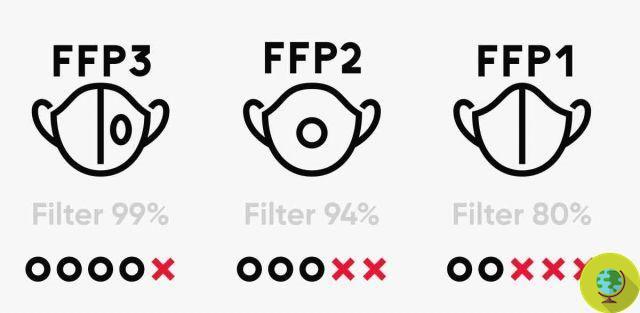Many wear the “filtering face” masks FFP1, FFP2 and FFP3 masks. But how long do they last? And are they reusable?
Don't store avocado like this: it's dangerousMasks and coronavirus: the (almost) perfect combination that has been with us for a year now. A year in which water (and viruses) has passed under the bridges, but in which one fact has remained firm: personal protection is the only weapon we have to get out of it unscathed. This means: limiting contact, washing your hands anytime, anywhere and wearing one mask. But which is the best?
The vast majority of people wear the "classics" surgical masks and they are fine. But then there is a large slice of the population that instead makes use of the so-called "filter face" masks FFP1, FFP2 and FFP3 masks). Are there any substantial differences? How long they last? And are they reusable?
Read also: Coronavirus: which masks are really effective?
A first element is certain: the filtering facepieces are mostly used in the care hospital setting for protect the user from external agents (also from transmission of infections by droplets and aerosols), while surgical masks are designed to prevent the wearer from contaminating the environment, as they limit the transmission of infectious agents.
The UNI EN 149: 2009 technical standard applies to the filter elements, which specifies the minimum requirements for anti-dust filtering half masks, used as respiratory protection devices (called FPP2 and FPP3), in order to guarantee the characteristics of efficiency, breathability, stability of the structure through tests and technical tests.
Index
FFP2 and FFP3 masks, what they are
They are filtering face masks used in hospital and care environments to protect the user from external agents (including from transmission of infections by droplets and aerosols), they are certified in accordance with the provisions of Legislative Decree n. 475/1992 and on the basis of harmonized technical standards (UNI EN 149: 2009). The filter masks protect against inhalable dust, fumes and mists of liquids (aerosols), but not from steam and gas.
They are divided into three classes, they protect against aerosols, smoke and aqueous and oily fine dust during work and are called “filtering half masks against particles or masks for fine dust”. The classification system is divided into three FFP classes, where the abbreviation FFP stands for "filtering face piece", or filter mask. And they are:
- FFP1
- FFP2
- FFP3
Le FFP1 they protect against non-toxic and non-fibrogenic dusts and are suitable for environments where toxic or fibrogenic dusts and aerosols are not expected. These they filter at least 80% of the particles found in the air down to a size of 0,6 μm, have an inward leakage of less than 22% and are unsuitable for protection from airborne pathogens.
Le FFP2 they protect against dusts, smoke and solid and liquid aerosols that are harmful to health and are suitable for environments where the air contains substances that are harmful to health and capable of causing genetic alterations. This type of masks filters at least 94% of the particles found in the air down to a size of 0,6 μm. (they are for example used in the metallurgical industry or in the mining industry) and an inward loss of less than 8%.
Le FFP3 they also protect against dusts, smoke and solid and liquid aerosols that are toxic and harmful to health. They filter at least 99% from particles up to 0,6 μm in size, they are also able to filter toxic, carcinogenic and radioactive particles and have an internal loss of less than 2%. These respiratory masks are used for example in the chemical industry.
All of them can also be equipped with valves, which have no effect on the filtering capacity of the device, but simply allow for better breathing when the mask is worn for a long time.

©Vector Icon Flat/Shutterstock
Are FFP2 and FFP3 reusable?
In most cases, FFP filters are disposable. But just read the wording on them to understand it. In addition to the CE mark, in fact, the filtering half-masks bear the code of the EN 149 standard with the reference year, the FFP classification and the mandatory indication R or NR, and the optional one D.
- "R" stands for reusable,
- "NR" for non-reusable,
- “D” refers to any clogging test
For example, the EN 149: 2001 + A1: 2009 FFP2 NR D marking indicates compliance with the standard, the type of filter (FFP2), the disposable classification (NR) and the carrying out of the optional clogging test (D).
How long they last?
The classification R or NR already gives an answer in itself. In general, however, the filter masks have the duration of a work cycle, on average 8/10 hours, but in a contaminated environment. That is, they have been tested to protect the user even in the presence of high numbers of PM10 and PM2,5 (particulate matter).
Source: Ministry of Health
Read also:
- Surgical masks: can be used up to 5 times by washing them in the washing machine. The Altroconsumo survey
- What happens if you wash the surgical masks after using them, according to a new French test
- Cloth masks should be washed every day (otherwise they won't work). I study


























